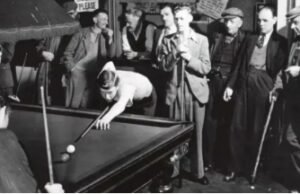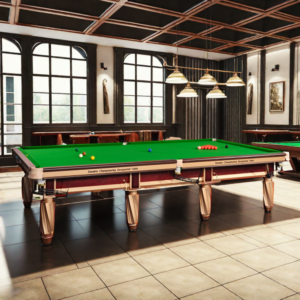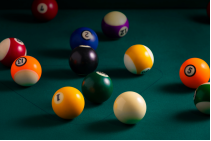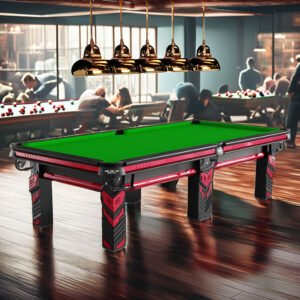Home »
Billiard Table: A Link for Cross-Cultural Communication
The Magnificent Transformation of Billiard Table Craftsmanship and Design
Billiards is a globally popular sport. As the core carrier of this sport, billiard tables have undergone earth-shaking changes in craftsmanship and design over hundreds of years. These transformations have not only enhanced the experience of playing billiards but also promoted the sport’s development towards professionalism and competitiveness.

Early billiard tables were extremely simple, merely assembled from simple wooden planks and covered with rough fabric on the surface. With the rise of billiards among the aristocracy, the demand for the quality of billiard tables led to a gradual improvement in craftsmanship. In the 18th century, slate began to be used in the production of billiard table surfaces. The flatness and stability of slate far exceeded those of wooden planks, providing a more accurate plane for the rolling of billiard balls, greatly enhancing the playing experience, and promoting the professional development of the sport of billiards. At the same time, the quality of the billiard cloth has also been continuously improved. From the initial rough fabric that easily affected the ball’s speed and trajectory, it has developed into today’s delicate, smooth, and durable finely woven billiard cloth, optimizing the ball’s movement performance and enabling players to control the hitting force and direction more precisely. Spike uses Grade A bluestone from Jiujiang to create the table surface, and it is matched with the independently developed billiard cloth, making the table sturdy and durable, and the ball movement smoother.

The Industrial Revolution brought a qualitative leap to the manufacturing of billiard tables. The progress of mechanical processing technology has greatly improved the cutting precision of slate, enabling it to meet higher standards of flatness requirements. The innovation of billiard cloth production technology has enabled the large-scale production of high-quality products, reducing costs and allowing more people to access high-quality billiard tables. In the 19th century, the manufacturing process of billiard table frames was significantly improved. Solid wood materials were used, and through fine polishing and carving, they were not only sturdy and durable but also highly artistically appealing. During this period, the design of billiard tables branched out. Due to differences in playing styles, English and American billiard tables gradually differentiated in terms of size and pocket design. English billiard tables are larger with smaller pockets and require extremely high precision; American billiard tables are relatively smaller in size with larger pockets, and the playing style pays more attention to power and continuous offense, which provides diverse choices for players with different preferences. Chinese-style billiard tables, on the other hand, have simple and easy-to-understand rules, require a high level of comprehensive technical skills, and have strong competitiveness. This competitiveness increases the tension and appreciability of the game and also tests the players’ psychological quality and adaptability.

In modern times, billiard tables have continuously made breakthroughs in material and technological innovation. In terms of materials, new materials such as carbon fiber and high-strength alloy are applied to the frame manufacturing, reducing weight and enhancing stability and durability. For example, some high-end billiard tables use carbon fiber frames, which, while maintaining high strength, make the billiard tables more lightweight and convenient for handling and installation. In terms of technology, the integration of intelligent technology has brought a brand-new experience to billiard tables. The application of intelligent sensors can accurately record data such as ball speed, hitting points, and the movement of the cue ball, providing strong support for players’ training and game analysis. Some billiard tables are equipped with a constant temperature and humidity control system, which can automatically adjust the temperature and humidity of the billiard cloth and slate to ensure that the performance of the table is not affected by the environment and always remains in the best condition.

In terms of appearance design, billiard tables have evolved from a single style to a diversified one. In addition to the classic traditional style, modern minimalist styles and characteristic styles that incorporate cultural elements have emerged continuously. Traditional-style billiard tables, with exquisite solid wood carvings and retro tones, exhibit a noble and elegant temperament and are suitable for placement in high-end clubs and private clubs. Modern minimalist-style billiard tables, with simple lines and modern materials such as metal and glass, create a fashionable and technological atmosphere, complementing modern homes, trendy bars, and other environments. Billiard tables that incorporate cultural elements are even more unique. For example, Chinese-style billiard tables incorporate traditional Chinese elements, such as dragon patterns, auspicious cloud carvings, and table legs in the shape of palace lanterns. Spike perfectly combines cultural connotations with modern competition, creating a series of billiard tables that have become unique works of art, adding a strong cultural atmosphere to the billiard hall space.
Looking to the future, the craftsmanship and design of billiard tables will continue to innovate. On the one hand, with the increasing popularity of environmental protection concepts, recyclable and biodegradable environmentally friendly materials are expected to be more widely used in billiard table manufacturing. On the other hand, driven by virtual reality (VR) and augmented reality (AR) technologies, billiard tables may break through the limitations of physical space, creating a more immersive and interactive new experience for players and opening a new chapter in the sport of billiards. The transformation of billiard table craftsmanship and design is a vivid manifestation of the continuous integration of technological progress and human needs. Spike will continue to inject new vitality and charm into the sport of billiards.





